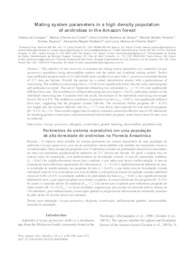Mating system parameters in a high density population of andirobas in the Amazon forest.
Mating system parameters in a high density population of andirobas in the Amazon forest.
Author(s): CAMPOS, T. de; CUNHA, M. O. da; SOUSA, A. C. B. de; TEIXEIRA, R. B.; RAPOSO, A.; SEBBENN, A. M.; WADT, L. H. de O.
Summary: The objective of this work was to estimate the mating system parameters of a andiroba (Carapa guianensis) population using microsatellite markers and the mixed and correlated mating models. Twelve open-pollinated progeny arrays of 15 individuals were sampled in an area with C. guianensis estimated density of 25.7 trees per hectare. Overall, the species has a mixed reproductive system, with a predominance of outcrossing. The multilocus outcrossing rate (tm = 0.862) was significantly lower than the unity, indicating that self-pollination occurred. The rate of biparental inbreeding was substantial (tm - ts = 0.134) and significantly different from zero. The correlation of selfing within progenies was high (rs = 0.635), indicating variation in the individual outcrossing rate. Consistent with this result, the estimate of the individual outcrossing rate ranged from 0.598 to 0.978. The multilocus correlation of paternity was low (rp(m) = 0.081), but significantly different from zero, suggesting that the progenies contain full?sibs. The coancestry within progenies (O = 0.185) was higher and the variance effective size (Ne(v) = 2.7) was lower than expected for true half-sib progenies (O = 0.125; Ne(v) = 4). These results suggest that, in order to maintain a minimum effective size of 150 individuals for breeding, genetic conservation, and environmental reforestation programs, seeds from at least 56 trees must be collected.
Publication year: 2013
Types of publication: Journal article
Unit: Embrapa Acre
Keywords: Allogamy, Alogamia, Andiroba, Carapa Guianensis, Conservation, Conservação, Crossing, Cruce, Cruzamento, Essência florestal, Fitomejoramiento, Genetic breeding, Genetic markers, Madera tropical, Marcador genético, Marcador microssatélite, Marcadores genéticos, Melhoramento genético vegetal, Microsatellite repeats, Microssatélite, Plant breeding, Repeticiones de microsatélite, Reprodução vegetal, Tropical wood
Observation
Some of Embrapa's publications are published as ePub files. To read them, use or download one of the following free software options to your computer or mobile device. Android: Google Play Books; IOS: iBooks; Windows and Linux: Calibre.
Access other publications
Access the Agricultural Research Database (BDPA) to consult Embrapa's full library collection and records.
Visit Embrapa Bookstore to purchase books and other publications sold by Embrapa.

